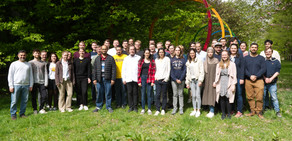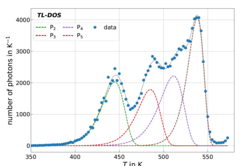Dosimetry
An important aspect in radiation protection, and especially in medical physics, is dosimetry. Particularly in the field of personal dosimetry, a reproducible and fast technique is indispensable to reliably inform radiation-supervised persons in case of exposure. Common types of personal dosimeters are, for example, gliding shadow film dosimeters, which are read out once a month in routine operation. Since this type of personal dosimeter will not be available in the near future, our working group is cooperating with the material testing office (Materialprüfungsamt NRW - MPA), which is launching new dosimeters based on thermoluminescent crystals, the TL-DOS dosimeter system.
The electrons generated by ionization upon irradiation are trapped in localized metastable states in the band gap of the LiF crystal. For readout, the detector is heated, which releases the electrons again and they subsequently recombine to emit photons (thermoluminescence). The number of photons then serves as a measure of the dose deposited in the detector. Electrons from traps located at different depths in the bandgap are excited back into the conduction band at different energies, resulting in a characteristic pattern of photon rate as a function of detector temperature. The exact course of this so-called glow curve depends, among other things, on how long ago the detector was irradiated. Our working group is concerned with exploiting this dependency in order to retrospectively determine the time of dosimeter irradiation as accurately as possible, so that changes in radiation protection measures can be made to the work routine of the person affected in order to avoid further exposures in the future. The determination of the irradiation period is done with modern methods of machine learning, such as Generative Adversarial Networks. This has already made it possible to determine the time of an irradiation with an accuracy of 2 days after one month of wearing the dosimeter.
Dose prediction for radiation planning using machine learning
Another application of machine learning in medical physics is rapid dose prediction for radiation planning. Modern radiation planning systems make dose predictions using Monte Carlo simulations, which are very accurate but also computationally very time consuming. In particular, in so-called flash therapy, where very thin but very intense photon beams deposit high doses in small volumes of a tumor, dose prediction by simulation is very time-consuming. Due to the small structures and high dose rates, very extensive simulations are necessary. Therefore, in order to complete radiation planning within a feasible time, the spatial distribution of the deposited dose is to be predicted using a neural network. Currently, this technology allows a reduction of the time needed for planning by a factor of 10 000.
Funded by:






